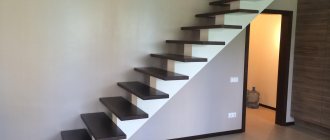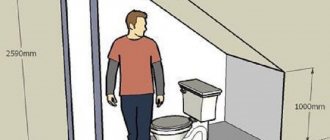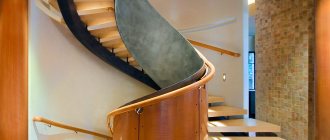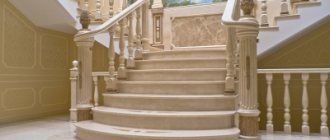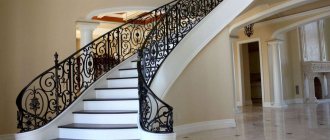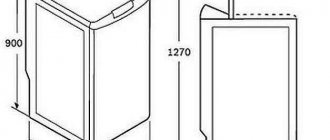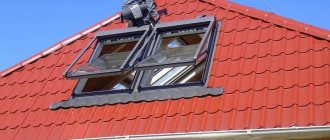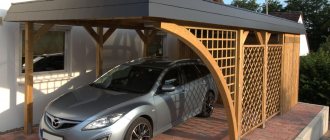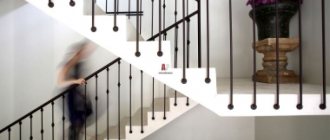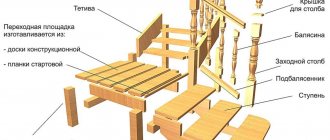A staircase to the second floor in a private house must be not only beautiful, but also practical.
Thanks to stairs, you can easily move from floor to floor, both in apartment buildings and in private ones, consisting of two or three floors. If, when calculating the construction of a private house, it is planned to build two or more floors, it is necessary to plan a staircase in it, even at the construction stage, and if the house is large enough in area, then even two internal staircases can be provided, and the second one can play the role of an auxiliary one.
Stairs to the second floor for a summer residence
When choosing a design, as well as the material from which the staircase will be made, it is important not to forget about safety and ergonomics.
Based on the above, we can identify a number of criteria by which the choice of materials and its design is made:
- The place where the staircase will be located relative to the room, as well as the dimensions of the staircase itself, and the number of square meters that are planned to be allocated for the staircase;
- The level of safety of the entire structure - if small children and elderly relatives will live in the house with their parents, then it is worth designing the staircase taking into account maximum safety for them;
- The type of staircase and methods of attaching it to the walls or fastening it using modular structures, as well as the interior of the entire room in which the staircase will be installed.
You should carefully choose a staircase model in a country house. What shape and design it will be, as well as the material from which it will be made. If you make the wrong choice, it may not meet safety standards and the overall interior of the entire room; you may end up with a not entirely economical option.
Types of stairs for small rooms
Today there are a large number of models of small stairs, each of which has both advantages and disadvantages of operation. The choice of design is influenced by the dimensions of the staircase opening, its shape, width, length and height. The final result of the styling depends on the correct calculation of these parameters.
In conditions of limited space, an excellent solution would be to install the following models of small stairs to the second floor:
- Screw. These are unsafe structures of the original form. Not suitable for homes with elderly people and small children.
- Rotary. They provide maximum space savings - they are often ordered for two-level apartments.
- Modular. They are in great demand due to their unusual shape and stylish design; expensive materials are often used for their production.
- Attached. Outwardly they resemble stepladders and are very unstable structures.
- "Goose step" A distinctive feature of such models is that you can stand on them with only one leg.
- Attic. Their main disadvantage is the need to constantly clean up the structure for the next use.
It is important to take into account the shape of the staircase opening - a screw design is suitable for round and square ones; for a narrow opening, a small L-shaped staircase to the second floor is best suited.
If safety is most important to you, then we recommend paying attention to U-shaped stairs - they are the most comfortable to use, although they take up quite a lot of space.
On the video: the main types of stairs.
Wooden
A variety of materials can be used to make such structures, but wood is still in great demand. A wooden staircase in a small country house not only serves as an important stylistic element of the room, but also allows you to save space in adjacent rooms.
Stairs made of natural wood are popular due to the undoubted advantages of this traditional building material:
- environmental friendliness;
- durability;
- ease of processing;
- reliability;
- variety of wood species.
The best option is to place the staircase structure in the center of the living room or dining room, so it will take up minimal space and fit seamlessly into any design. It is important that the color scheme of the staircase is combined with the overall design, and that the steps are comfortable for movement.
A wooden staircase is perfect for a small opening and is the safest version among the popular small-sized models.
If you plan to make the base of the staircase structure yourself, then pay attention to the metal frame (on top of which a wooden sheet is placed). Even a novice master can easily perform this option. And treads lined with wood retain heat for a long time and give a feeling of comfort.
Article on the topic: Stool with transformation into a ladder - a universal chair or two items in one
Modular
Modern technologies make it possible to create the most incredible designs. This rule applies to a greater extent to modular stairs. Such models in a small space look unusual, even extravagant due to their unique assembly and allow you to “play” with space.
The advantage of such models is the possibility of self-installation, depending on the chosen form. Thus, a modular staircase can have a right angle or an inclination of 180 degrees, be spiral-shaped, screw-shaped, rounded or L-shaped. In this case, the opening parameters do not matter much - such stairs can be installed in long, narrow, short and wide niches.
Improperly designed staircases pose a huge danger to home occupants, especially for modular staircases used in confined spaces. Take a responsible approach to choosing a construction company; it is better to entrust such a matter to professionals to avoid problems in the future.
Remember that steep stairs are not safe for children and people with disabilities.
Experts highlight several basic tips for choosing modular stairs for small spaces (living rooms, corridors, dining rooms):
- To determine the size of the structure, you need to measure the area of the room and take measurements of the opening (into which the staircase will subsequently be installed).
- A simple modular design is very unsafe; during the construction process, the stairs should be equipped with protective railings.
- For more convenient movement on sharp turns, we recommend paying attention to stairs without risers (such models are easy to install and comfortable).
- When choosing a design design, do not forget about the color balance and stylistic unity of the room, especially when it comes to the design of living rooms.
The staircase in small rooms (in two-level apartments) should first of all be safe, and then beautiful and easy to use. Compact turns will be an excellent addition to a narrow opening, solve the problem of zoning rooms and at the same time save a lot of space in the house. This option is optimal for quickly moving between floors, although the narrow steps cannot be called safe.
Related article: How to make a staircase from a profile pipe: design selection, calculation and assembly |+50 photos
Safe
The main danger of small-sized structures is the presence of narrow steps and sharp turns. That is why the choice of this interior element should be approached with special responsibility. It is important to take into account the factor of “compliance with dimensions and parameters” - this determines the safety of stairs in small rooms. The dimensions of the flights of stairs should be the same, and the railings should not be too high.
Another important point when choosing a staircase is the slope of the steps, because a strong deviation in one direction or the other can lead to a fall. To improve the safety of modular turns, special standards have been developed. Compliance with them will help avoid accidents.
Safety standards for selecting small structures:
- The optimal vertical distance from the surface of the steps to the ceiling should not be less than two meters (this rule does not apply to attic models).
- Pay attention to the length of the opening - upon completion of all work, the structure should not interfere with normal movement between the first and second floors.
- The minimum opening width is 60 centimeters. Make sure that the staircase matches this indicator.
- Discomfort may arise as a result of incorrectly selecting the height of the steps.
Sometimes compact designs make the room even more uncomfortable, taking up an already limited space. If there is no space in the apartment for arranging a staircase turn, then it is worth thinking about the location of the external staircase in the side niche.
Over many years of practice, builders have discovered one simple truth - the larger the staircase opening, the more convenient it is to move between floors and rooms, and vice versa.
The main problem with small openings is the need to constantly bend down to move from one room to another. Therefore, if you are just planning the construction of a country house or a major renovation of an apartment, then do not skimp on space for arranging the stairs. This will protect you from problems with choosing a suitable design in the future. And do not forget that the main criterion in this case is not external attractiveness, but safety.
Mistakes in designing stairs in a wooden house (1 video)
Design solutions for small-sized houses (52 photos)
Dimensions of staircase steps in a country house to the second floor
You can build ready-made interfloor stairs in a private house, but you should take into account not only their size, design and material, but also the dimensions of the steps in width, length and height. Ideally, the width of the steps should be 120 cm, the dimensions of the step itself should be 25–30 cm, and the height between the steps should be 15–18 cm. But it is not always possible to maintain such ideal proportions.
In addition, the dimensions of the staircase steps for each individual structure will be slightly different, for example:
- The most common staircase design in a private house is a straight single-flight staircase; the optimal width of steps for such a design is 100 cm. At the same time, it remains possible to construct a fence, and such a staircase does not take up much space.
- If a spiral staircase is installed in a private house, then in this case the minimum width of the steps should be 80 cm. But, if the staircase is secondary and is used mostly for household needs, you can reduce the width of the steps to 60 cm.
- There are other non-standard solutions for stairs, for example, folding or emergency ones; such stairs, as a rule, have the width of the steps reduced to 50 cm.
In general, all dimensions of the staircase, such as height, length and width of steps, slope, as well as the width of the staircase itself, are calculated based on the area of the room, because the larger the size of the staircase, the more area it needs in the room.
Criterias of choice
When installing a staircase for small openings in a country house or country house, first of all you need to pay attention to the design features of the selected model. Before ordering, it is recommended to consult with a specialist, taking into account not only the style of the interior, but also the factors that determine the convenience of the subsequent use of the staircase.
Such criteria include:
- Small dimensions - the dimensions of the structure must correspond to the area of the room, especially in limited space.
- Convenience - non-slip material of the steps, suitable height of the railings.
- Safety - use of high-quality materials and compliance with installation rules.
The choice of a small-sized staircase should be approached with special responsibility. It is necessary to take into account the wishes of all residents and the features of the building. If there are small children in the house, then the option without railings will be very inappropriate. It is also worth refusing to use steep structures, because a child may inadvertently trip and fall head over heels.
The selection of the level of steps is also important - for schoolchildren and pensioners it will be difficult to constantly climb the higher ones. To increase the safety of the structure, cover the staircase with a carpet. This will look stylish and will avoid the problem of “slippery floors”.
Why are small-sized stairs so popular? The answer to this question lies in the versatility of the design, in its compactness. This is also due to the main task of the staircase - the competent distribution of free space due to its unique design, which allows you to arrange the steps so that they do not take up much space and at the same time are convenient for constant use.
In addition to the advantages of using this type of structure, it is worth noting the main disadvantage of compact stairs - they have to be made as steep as possible (the angle is at least 45 degrees, and the depth of the steps is minimal). Externally, such stairs look very compact, but not safe.
In order to improve the performance characteristics of the stairs, it is necessary to install handrails or special handles (which will be convenient to hold during descent or ascent).
In the video: which staircase to choose for the 2nd floor.
Related article: Basic options for lighting stairs in a house and selection criteria (+58 photos)
Width of the country staircase to the second floor
There are no specific standards or video instructions for stairs installed in private houses, in contrast to multi-storey residential buildings, where such structures must comply with all SNiP standards. In private houses, staircases of different sizes and shapes are installed.
When designing a staircase, it is worth taking into account certain parameters, such as the size of the room, the number of people living, as well as the presence of children and elderly people, and the design of the staircase itself. ,
Based on all this, it is necessary to design stairs and their further production according to certain parameters.
Namely:
- The minimum width of a staircase in a private house should be no less than 90 cm, and ideally the width of the staircase should be 120 cm. This is primarily due to fire safety, so that in the event of a fire, the staircase does not become a bottleneck during evacuation.
- The steps on each flight (if it is a two-flight or more staircase) must be the same width, as well as the same height and length.
You can, of course, make the width of the stairs smaller, but this will not be entirely comfortable for moving along it.
In addition, narrow stairs will make it difficult to move any bulky items. A narrow staircase width can be made if it is rarely used, for example, to go down to the basement or to go up to the attic.
Designs and types
The staircase design plan for a country house should take into account the amount of free space. The greatest freedom of imagination can be given to the owners of large dachas, in which a minimum of 3 meters is allocated for the span. Then you can use almost any design, and the remaining space under the steps can be used for storing things. If there are only a couple of meters left to climb, you will have to make a steep or screw structure.
Marching
You may be interested in a DIY chaise longue: drawings with dimensions, step-by-step instructions. A frame shed is an excellent household building with your own hands. How to make a concrete fence with your own hands: installation and installation of fences. Such rises are popular in all types of houses.
They are tailored to the natural gait of a person, therefore they are safe and do not disrupt the biomechanics of the step. One flight can include from 3 to 15 steps. If the height difference is too large, this amount is not always enough, so it is created with platforms without steps. Such staircases to the second floor in private houses are called double-flight. The design comes in different forms. If the rise is too large and there is not enough space, you can avoid the steep slope of the stairs in the cottage. “P” and “L” turns can compensate for tilt. All marching structures are on stringers or bowstrings. In the first type, the beams that are located under the steps become the load-bearing support. The bowstring structure is attached through grooves, which must be taken into account at the design stage.
Attention!
The steps in the flight of stairs to the second floor at the dacha are of the lightweight type (without risers) and the heavy type (with them). For a classic style, the first option is suitable. Techno, hi-tech and minimalism require greater lightness.
Screw
Such structures are built in small houses. The base is a rod that is fixed to the floor and ceiling. There are steps arranged in a spiral along it, which widen towards the edges. Such stairs do not take up extra space and fit even in a corner. However, the screw type has a number of disadvantages:
- they are impractical for young parents, because... children may fall;
- the base is less strong than that of marching structures, so there is a feeling of unreliability of the steps;
- a spiral staircase to the second floor is not installed in houses where older people come, who find it difficult to take uneven steps.
In screw structures, the proportions of the steps are important. The narrow edge must be at least 20 cm, otherwise the rise will be traumatic. The wide side of the steps is 40 cm. If the value is less, the climb will be fraught with falls, especially for people with poor coordination. 40 cm is enough for a person to intuitively move his foot to a new area with each step. The length of the steps is important. The total radius must be at least 1.5 meters.
On the Bolts
This rise is used in modern design, where creative elements are needed. It cannot be placed in rooms. The main condition for a staircase on rails is a load-bearing wall. This is precisely the basis. The design is suitable for houses decorated in a minimalist style. There are no support beams or other elements under the steps, so the space visually increases. These stairs look unreliable. This is a misconception: each step on the rails can withstand from 500 kg to 1000 kg.
Do-it-yourself design of country stairs to the second floor
The construction of a private house involves not only laying the foundation, building walls, floors and roofs, but also making stairs to move from floor to floor. And before making a staircase, you should consider whether the living room and the hallway allow you to place a new object.
The staircase should be designed taking into account all the necessary parameters, and taking into account where it is planned to be installed:
- To determine the number of steps, it is necessary to measure the height from the floor of the first floor to the floor level of the second floor. After determining the height of the steps, usually it is made equal to 150 mm, then all that remains is to divide the height of the entire future staircase by the height of the steps.
- The angle of inclination of the future staircase should be in the range of 22-40 degrees, the optimal angle of inclination is considered to be 37 degrees. To determine what the optimal angle of inclination will be, you should make a drawing and visually see how it will all look.
- When designing fences and railings, certain standards should be taken into account, which state that their height should be no less than 90 cm, and if the staircase is spiral, then no less than 110 cm. The distance between the balusters that form the basis of the fence should be about 120 mm, especially if there are children in the house.
Knowing now the necessary parameters, you can design almost any staircase for your home, and you can even do it yourself without any problems, in accordance with all regulatory safety requirements.
Only a properly designed and manufactured staircase will last for many years.
The role of stairs in a home
The staircase at the entrance to the home plays an important role, and its arrangement must be given the utmost attention, since it takes on a large load.
Let's try to figure out how to make a wooden staircase for a porch with your own hands, choose the right material, shape and color of the structure, so that it creates harmony with the porch of the house.
Advantages of wooden stairs to the porch
- Ease of processing the material;
- Low weight does not create obstacles for transporting wood;
- The ability to create fancy decorative designs;
Disadvantages of wooden stairs to the porch
The disadvantages of some types of wood for creating a wooden staircase for the porch of a house can be compensated for by the correct selection of material.
How to choose wood for the stairs to the house
Pine staircase
- Needs periodic treatment with antiseptic compounds against rot;
- The density of the material is low compared to larch;
- Can be easily processed;
- The cheapness of wood and its widespread availability make it popular.
Larch stairs
- High density of wood (the material can last for centuries and turn into stone);
- Resistance to putrefactive processes and deformation;
- Expensive;
- It has a low prevalence in the building materials market, since its growing area is small. Importing larch from remote regions only increases its cost.
Thus, pine is a more affordable and budget-friendly material for making wooden stairs to the porch with your own hands. Larch, if desired, can be afforded by home owners for whom costs are not of great importance.
Drawing a drawing of a wooden staircase for a porch
This stage before starting work is a mandatory point in the process of creating stairs for the house. To make a high-quality sketch, it is necessary to carry out careful measurements and calculations, taking into account the following parameters:
Structure height
To get it, you need to measure the distance from the ground to the top of the porch or doorway if the staircase is planned directly to enter the house.
As a last resort, you need to make a gap from the door opening to the top step, taking into account the fact that wood is prone to expansion when humidity is high, and this threatens to block the entrance.
Stair slope angle
After measuring the height of the stairs, it is necessary to calculate the maximum expected slope. When making calculations, remember that an extremely steep staircase is inconvenient to use, and a too sloping one takes up a lot of space.
The angle of inclination of the structure is adjusted by lengthening or shortening a continuous sequence of steps between two platforms.
Length of string or bowstring
The bowstring is a structure with special grooves that are necessary to secure the steps. Stringer - the design of a flight of stairs, is a beam with a comb located on it for installing steps.
Scheme for installing steps for a wooden staircase on stringers on the porch and bowstrings.
Important! Do not build a very steep or sloping staircase, if its length is within 5 meters.
Formula for calculating stringer c = a / sin (α)
- c is the length of the stringer;
- a is the height of the stairs;
- α is the roll angle of the flight of stairs.
Taking into account the angle of inclination of the stairs, you can calculate the distance to the first step from the porch using the formula for the length of the stringer:
- a – height of the stairs;
- b – gap to the first step from the porch;
- c – length of the flight of stairs
The width of the stairs most often corresponds to 9 m, so that at least a person can stand on it. If the yard area allows, the staircase can be made wider for the convenience of the residents of the house.
Window on the interfloor staircase for a summer residence
In order to be able to move up the stairs completely safely, it is necessary to install lighting that will be effective in the dark. But in order not to waste electricity, you need to take care of natural lighting and make a window, and if possible several, even small ones, to illuminate the stairs during the day.
But, when installing them, it is necessary to take into account the following points:
- The shape of the window should correspond to the general style of the house, therefore, before planning such windows, you should look at the photo samples of windows in order to choose the most optimal options.
- The window should not only let in enough light, but it should also retain heat well. Large panoramic windows look beautiful, but are not suitable for most Russian territories. It is better to get by with several small windows.
Pouring a concrete street staircase
Let's return to cement mortars and consider their use outside the home:
- Purchase of cement mortar, second-rate boards for formwork, reinforcing mesh and finishing material with which the concrete base will be lined.
- Preparation of the workplace begins with the creation of multi-level formwork from boards and bars. The height of the formwork is equal to the height of the steps, so it is necessary to calculate all the values in advance and work according to the project.
- Fixing the reinforcing mesh by tying horizontal and vertical rods. This will reduce the number of cracks and breaks that will appear over time when the stairs are used.
- Knead the solution and pour the finished mixture into the base up to the level of the second step and wait 15-20 minutes so that the pressure from the solution when pouring the next step is better contained.
- After a few days, you can remove the formwork and begin facing work.
Read a detailed guide on how to pour a monolithic staircase.
Design of stairs to the second floor in a country house (photo examples)
Stairs for a summer house and a private house with photos
A staircase is a structural element that is a functional structure and an indispensable piece of furniture in every multi-storey private house. Depending on the features and purpose of the product, they can be made of different materials with different installation technologies. Making a staircase for a summer house with your own hands is not easy, but it is possible. And for this you will need building materials, a hammer and nails. To decide on the type of design, you need to consider their modifications.
Installation and installation of stairs
Finally, the materials have been purchased, calculations have been made, and the drawing is ready. You can start building a wooden staircase for your home.
Installation of stringers and bowstrings
- The ends of the beams purchased for kokurov should be cut in accordance with the length of the stairs. Cut off the thickness of the tread from the bottom.
- Cut openings for steps. To do this, you need to mark the width of the tread and the height of the riser, subtract 2-4 cm. For convenience, use a construction square and mark the beam with a pencil. Saw off the excess parts with a jigsaw or saw.
- Place the stringer in place of the future staircase. The upper end should be in contact with the ceiling, the lower end should rest against the floor. Check that the cuts for the steps are strictly horizontal. For the stairs you need at least 2 stringers. If a very heavy load is expected, there may be more.
- Sand the surface with sandpaper. You can also mill the edges for safety (if there are children in the house) or for beauty.
- Connect the upper and lower stringers with a beam, cutting them into quarters on both sides. Anchor bolts are best suited for fastenings. Also, stringers can be additionally attached to the walls.
- When using one string, you need to shorten it to the required length. Cut holes inside it for the steps. Secure the string to the wall with anchor bolts. To regulate the level position of the bowstring and stringers, use a building level.
Installation of steps and risers
- Cut the beam based on the calculations - the number and width of risers. Align them with each other and sand them with sandpaper.
- Secure the risers to the stringer from the front side using self-tapping screws. Don’t worry that the appearance of the screws will ruin the aesthetics - they can later be puttied or hidden under special decorative “covers”.
- Saw the wooden beam based on the calculations for the steps. Remember that the last step is the floor of the second floor, so we subtract 1 piece from the total quantity.
- Sand the surface and mill the protruding outer edge at an angle.
- Place the steps on the risers and secure them with screws or self-tapping screws.
- Install the balusters and secure them with 100*8 mm pins.
- Install the railings on the balusters and secure them with self-tapping screws.
The wooden staircase to the second floor is ready! All that remains is to varnish it and add decorative elements if necessary.
What could be the design of the staircase?
The first stage of making a staircase is choosing its type. There are two basic types of structures: screw and with marches.
Screw design
The screw version, with the steps rotating 360 degrees, is convenient because it can be easily placed in a limited space without taking up much space. However, in order to make the elements, correctly design and calculate the parameters of a spiral staircase, professional skills are required; a specialized tool is a complex type.
If the characteristics of the room do not allow the use of other structures, it is worth ordering a ready-made kit, which is offered in the form of modules designed individually for the house, taking into account the height of the floors and other characteristics. The help of professional builders or installation specialists will help ensure the system is safe, durable and convenient.
Marching stairs
Models with marches are easy to manufacture; even a non-professional can handle it. Stairs of this type are:
- straight or rotating 90, 180 degrees (quarter-turn and half-turn, respectively);
- with a single flight, two or more spans;
- wall-mounted or free-standing and so on.
Marching structures, although they take up a lot of space, are easier to make with your own hands. If there is not much space, you should give preference to a two-flight model with a platform or winder-type steps - trapezoidal, rotary. When calculating the number of spans, they are guided by the general rule. If there are more than ten steps, it is better to divide them into parts. With a smaller number, you can limit yourself to one straight span.
A marching model is not as difficult to make as a screw model, so further recommendations are given specifically for it. Even in the simplest system, load-bearing structures must be provided - stringers (beams secured with bolts) or a string with recesses for winding the ends of the steps. It is fixed on one or both sides of the stairs - where it touches the wall.
The steps are structurally divided into treads (wooden dies located horizontally) and risers. These are vertical members that cover recesses and increase the overall strength of the system between floors. Even if the work is done exclusively with your own hands, it is not recommended to abandon risers, otherwise the staircase will not be reliable. The design of the fence is completed with handrails and balusters, the distance between which should be less than the circumference of a small child’s head. If there are two or more marches, support pillars will also be needed.
